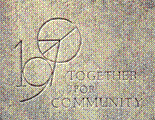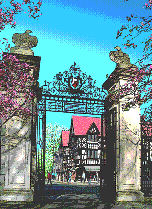

-- Jennifer Gennari Shepherd
 Across from Witherspoon and Nassau streets, the open wrought iron doors of the
imposing and elegant FitzRandolph Gateway
(56kb GIF) welcome visitors to Princeton
University. But it wasn't always so. This 90-year-old portal between town and
campus once was always closed except for the Alumni P-Rade and special
occasions. Just 25 years ago, the Class of 1970 requested that the gates
remain permanently open.
Across from Witherspoon and Nassau streets, the open wrought iron doors of the
imposing and elegant FitzRandolph Gateway
(56kb GIF) welcome visitors to Princeton
University. But it wasn't always so. This 90-year-old portal between town and
campus once was always closed except for the Alumni P-Rade and special
occasions. Just 25 years ago, the Class of 1970 requested that the gates
remain permanently open.
The closed gate represented an era of privilege rejected by student protesters of the 1960s, many of whom were demonstrating against the war in Vietnam. Opening the gate was another tradition to break. As a graduation gesture, the Class requested that the gate remain open.
"It was an emotionally intense time to be a college student," recalls Peter C. Kopff '70, founding partner of Kopff, Nardelli & Dopf in New York and former vice president of his class. Kopff remembers that many students protested during graduation and refused to wear the traditional black robes. The Class of 1970 also voted to alter commencement. Among the milder changes was the decision to process through FitzRandolph Gateway. The procession was another first, according to the Daily Princetonian, "intended to symbolize the seniors' commitment to those outside the university." Former class president J. Stewart McBride '70, now with United Digital Artists in New York, led the march through the gate. "We had a speaker who spoke about community and the idea of breaking down barriers between town and gown," he says. In the east pillar of the gateway, the Class motto, "Together for Community," is inscribed with a peace symbol in the zero of the 1970. The graduation procession warranted only brief mention in the Princeton Alumni Weekly in 1970: "In an act marking the end of one tradition and the beginning of another, the senior class marched out of the FitzRandolph Gateway."
The new tradition did not take root until the Class of 1988 formally added the march through the gateway to commencement exercises. Incorporating it into graduation validated a taboo which had taken hold of student imagination sometime during the 20 years after the gate was opened. "The legend is if you walk out of the gate [into Nassau Street] before you graduate, you won't graduate with your class," says Matthew Ferguson '96, chairman of the Orange Key Guides and a firm believer in the tradition; "My roommate walked out the gate, and he's not back this year." Ferguson is not alone in never exiting campus via the main entrance. "I never walk through it," says Tricia Cortez '96, executive editor of the Daily Princetonian. "I'm scared of it--I don't want to take the chance." No superstition forbids entering campus from Nassau Street, but Eric Emmons '96 commented that he never walks in or out of the main gate "because I don't know which way to avoid." Two small side gates make avoidance a simple choice for many students.
Built in 1905, FitzRandolph Gateway was the gift of Augustus Van Wickle, a graduate of Brown University and a Pennsylvania native who reputedly had only been to Princeton once in his life. When he died in 1898, he left $45,000 for a memorial to his great grandfather, Nathaniel FitzRandolph. FitzRandolph is the donor of the university's original four and a half acres on which Nassau Hall, the original building, was constructed.
In 1902, the Princeton Alumni Weekly reported that the FitzRandolph--or Van Wickle Gateway as it was briefly called-- might be built at the junction of Prospect Avenue and Washington Road. By 1904, it was decided; a triple gateway and fence designed by the New York firm of McKim, Mead and White would be built along Nassau Street in front of "Old North." Completed in 1905, the finished wrought iron fence stretches 278 feet long, and stands on top of a two-foot limestone and granite base for a total height of 10 feet. The two central limestone posts, crowned with two stone eagles and embellished with the University coat of arms, soar 24 feet high.
Until 1970, the main gate was opened only for the Alumni P-Rade and certain ceremonious occasions such as the conferring of honorary degrees to ex-presidents and foreign dignitaries. When the massive doors were swung open for the Crown Prince of Sweden's visit in 1926, the Princeton Alumni Weekly reported the reaction. "Freshman stood aghast. Sophomores were dumfounded. Juniors were amazed. Seniors were mildly surprised. Many townspeople were bewildered."
In those days, the decision to open the gateway was not taken lightly. According to a 1936 inter-office memo from University Secretary Alexander Leitch to University President H.W. Dodd, the president's suggestion to open the gate for the Daughters of the Cincinnati was rejected. Leitch noted the eight prior occasions on which the gateway had been opened, and wrote "In my judgment the Daughters of the Cincinnati do not fit in with the foregoing precedent." He then pondered the usefulness of continuing the tradition. "It seems to me that this precedent does permit the University to add a touch of distinction for distinguished visitors which would be diminished if the line were not carefully drawn," he wrote, "and in view of the fact that the precedent has been maintained for 30 years it would be easier and less confusing now to continue than to depart from it."
Surprisingly, given Leitch's opinion which prevailed another 34 years, the decision to open the gateway permanently was made without fanfare. As Director of Community and State Affairs Pam Hersh observed, the campus was never really closed to the public; anyone could walk onto the campus at another point. "The open gate merely symbolizes the strong relationship the University has had and continues to have with the town." .
Visitors and residents enjoy the use of the open FitzRandolph Gateway. At Communiversity, the annual celebration of the arts scheduled for April 22, town and gown will flow freely back and forth through the gate. Ask any student, however, and most will say they never walk out toward Nassau Street through the main entrance. They carry on the tradition begun by the Class of 1970; they wait until graduation to have the honor of passing through that portal.
 Return to Princeton Patron Magazine.
Return to Princeton Patron Magazine.